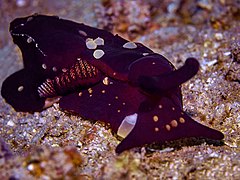Euthyneura
| Euthyneura | |
|---|---|

| |
| Cepaea nemoralis | |
| Scientific classification | |
| Domain: | Eukaryota |
| Kingdom: | Animalia |
| Phylum: | Mollusca |
| Class: | Gastropoda |
| Subclass: | Heterobranchia |
| Infraclass: | Euthyneura Johann Wilhelm Spengel, 1881[1] |
| Diversity[2] | |
| over 30000 species | |
Euthyneura is a taxonomic clade of snails and slugs, which includes species from freshwater, marine, aquatic and terrestrial gastropod mollusks in the clade Heterobranchia.
Euthyneura are considered the crown group of Gastropoda, and are characterised by several autapomorphies, but are named for euthyneury. They are considered to be the most successful and diverse group of Gastropoda. Within this taxon, the Gastropoda have reached their peak in species richness and ecological diversity. This obvious evolutionary success can probably be attributed to several factors. Marine Opisthobranchia, e.g., have evolved several clades specialised on less used food resources such as sponges or cnidarians. A key innovation in the evolution of Pulmonata was the colonization of freshwater and terrestrial habitats.[3]

Various phylogenetic studies focused on Euthyneura: Dayrat et al. (2001),[4] Dayrat & Tillier (2002)[5] and Grande et al. (2004).[6] Morphological analyses by Dayrat and Tillier (2002)[5] demonstrated the need to explore new datasets in order to critically analyse the phylogeny of this controversial group of gastropods. Klussmann-Kolb et al. (2008) traced an evolutionary scenario regarding colonisation of different habitats based on phylogenetic hypothesis and they showed that traditional classification of Euthyneura needs to be reconsidered.[3]
2010 taxonomy
Jörger et al. (2010)[7] have redefined major groups within the Heterobranchia and a cladogram showing phylogenic relations of Euthyneura is as follows:[7]
| Heterobranchia |
| ||||||
2014 taxonomy
Cladogram showing phylogenic relations of Euthyneura sensu Wägele et al. (2014):[8][2]
2016 taxonomy
Kano et al. (2016) proposed a new taxon Ringipleura and classified Ringiculoidea as sister group to Nudipleura:[2]
References
This article incorporates CC-BY-2.0 text from the reference[3]
- ^ Johann Wilhelm Spengel (1881). "Die Geruchsorgane und des Nervensystem der Mollusken". Zeitschrift für wissenschaftliche Zoologie 35(3): 333-383.
- ^ a b c Kano, Yasunori; Brenzinger, Bastian; Nützel, Alexander; Wilson, Nerida G.; Schrödl, Michael (2016-08-08). "Ringiculid bubble snails recovered as the sister group to sea slugs (Nudipleura)". Scientific Reports. 6: 30908. doi:10.1038/srep30908. ISSN 2045-2322. PMC 4976385. PMID 27498754.
- ^ a b c Klussmann-Kolb A., Dinapoli A., Kuhn K., Streit B. & Albrecht C. (2008). "From sea to land and beyond – New insights into the evolution of euthyneuran Gastropoda (Mollusca)". BMC Evolutionary Biology 2008, 8: 57. doi:10.1186/1471-2148-8-57.
- ^ Dayrat B., Tillier A., Lecointre G. & Tillier S. (2001). "New clades of euthyneuran Gastropods (Mollusca) from 28S rRNA sequences". Molecular Phylogenetics and Evolution 19(2): 225-235. doi:10.1006/mpev.2001.0926.
- ^ a b Dayrat B. & Tillier S. (2002). "Evolutionary relationships of euthyneuran gastropods (Mollusca): a cladistic re-evaluation of morphological characters". Zoological Journal of the Linnean Society 135(4): 403-470. doi:10.1046/j.1096-3642.2002.00018.x
- ^ Grande C., Templado J., Cervera J. L. & Zardoya R. (2004). "Molecular Phylogeny of Euthyneura (Mollusca: Gastropoda)". Molecular Biology and Evolution 21(2): 303-313. doi:10.1093/molbev/msh016.
- ^ a b c Jörger K. M., Stöger I., Kano Y., Fukuda H., Knebelsberger T. & Schrödl M. (2010). "On the origin of Acochlidia and other enigmatic euthyneuran gastropods, with implications for the systematics of Heterobranchia". BMC Evolutionary Biology 10: 323. doi:10.1186/1471-2148-10-323.
- ^ Wägele H., Klussmann-Kolb A., Verbeek E. & Schrödl M. (2014). "Flashback and foreshadowing—a review of the taxon Opisthobranchia". Organisms Diversity & Evolution 14(1): 133–149. doi:10.1007/s13127-013-0151-5
